https://kotaku.com/google-translate-makes-magic-the-gathering-cards-someh-1832327340

Some Magic: The Gathering fans are sending cards through Google Translate, with hilarious results.
via Kotaku https://kotaku.com
February 4, 2019 at 12:06PM

For everything from family to computers…
https://kotaku.com/google-translate-makes-magic-the-gathering-cards-someh-1832327340

Some Magic: The Gathering fans are sending cards through Google Translate, with hilarious results.
via Kotaku https://kotaku.com
February 4, 2019 at 12:06PM
https://www.wired.com/story/warby-parker-augmented-reality-app

Searching for the right pair of glasses is an exercise in patience. The frames that look best on the shelf never seem to look the same once you put them on. Temples get pinched; eyes look crossed. And—wait—has your head always been shaped like that?
Warby Parker, the direct-to-consumer eyeglass brand, disrupted this process with its system for trying on glasses at home. Choose five frames from the Warby Parker website and the company mails them to you for free. You then wear these loaner specs around (to work, to parties, or anywhere you’re sure to get compliments) before committing to a purchase.
Now the brand wants to upend the traditional retail experience again—this time with augmented reality.
Leveraging the face-mapping tech on Apple’s iPhones, the Warby Parker app will now include a a “virtual try-on” feature, which lets customers preview what glasses would look like in impressive detail using augmented reality. Download the app, choose a pair of frames, then swipe down to activate “virtual try-on,” which opens the front-facing camera and maps the glasses onto your face. The glasses stay fixed in place as your turn and tilt your head, and even show the way light filters through a pair of acetate frames or shine on metal details. I tested the feature against the pair of Warby Parker glasses I already own, and the virtual version of my frames looked identical to the real thing.
“Virtual try-on” belongs to a crop of new consumer-facing apps and tools that take advantage of the recent gains in AR tech. Want to see that Ikea bookshelf in your living room before you schlep it from the store (and assemble all those tiny pieces)? Preview it in augmented reality. Want to try on that T-shirt without waiting in line for the fitting room? Use an augmented-reality fitting room instead.
Eyewear-makers stand to gain loads from these apps. For one thing, advances in face-mapping technology translate well to stuff you wear on your face—which is why cosmetic brands like L’Oreal, Cover Girl, and Sephora have each developed their own versions of virtual try-on for makeup. It also reduces some of the friction in buying eyeglasses, and not only for the consumer; brands like Warby Parker can’t keep their show floors stocked with every single frame or offer all of them for home try-on.
For those reasons, Dave Gilboa, Warby Parker’s cofounder and co-CEO, says a virtual try-on feature has been on the brand’s road map since the company was launched nine years ago. “We’ve been patiently waiting for technology to catch up with our vision for what that experience could look like,” Gilboa says.
Warby Parker’s early experiments with augmented reality, like an AR filter for Snapchat, felt more like gimmicks. It was easy to superimpose the image of the frames onto the image of a person’s face, but Neil Blumenthal, Warby Parker’s other cofounder and co-CEO, says the company wanted to wait for something more true-to-life. “Until we were able to have a one-to-one reference and have our glasses be true to scale and fit properly on somebody’s face, none of those tools were functional.”
Then Apple announced the iPhone X. Its signature feature, the TrueDepth camera, enabled all kinds of sophisticated tricks (Face ID! Animoji! Super cool slo-mo!) that would usher in a new era of augmented reality. The TrueDepth camera projects a mesh of 30,000 infrared dots onto a person’s face, creating a 3D model of their facial topography. That made it possible for developers to build apps that modeled the actual fit of wearable products. (Yes, the new AR-enabled app is iOS-only; Android users are stuck using Warby Parker’s mail-order service for the time being.)
King Children, a startup that makes custom eyewear, also uses Apple’s TrueDepth technology to let customers preview a pair of glasses and take fit measurements to personalize things like the lens height and width, the nose bridge, and the nose pad position. Each pair of glasses sells for $125, a price similar to Warby Parker’s frames. San Francisco-based brand Topology also uses the measurements from the TrueDepth camera to deliver custom eyewear.
“We’re able to capture about 85 million accurate data points on your facial structure, which we use to drive eight variables that fit the frames to your face,” says Sahir Zaveri, King Children’s cofounder and CEO. He says this allows King Children to serve a more diverse customer base and provide real customization beyond just letting people preview a pair of frames before they buy. For him, the promise of augmented reality goes beyond simply trying things before you buy them. It’s about delivering something truly customized, beyond the one-size-fits-all model of current retailers.
For Warby Parker, “virtual try-on” is designed to reach more potential customers. The app also includes social sharing features, built to mimic the behavior from the company’s showrooms. “We’ve observed that in our stores, where people often come in with their friends or family members,” Gilboa says. “People will often take selfies and text those photos or post them to social media to get feedback.”
It’s a fun way to try on new styles or to confirm that no, you really cannot rock those candy-red cat-eyes. But the companies investing in AR try-on apps are hoping that fun and ease translates into you actually buying a pair of frames instead of just lusting after them from afar.
via Wired Top Stories http://bit.ly/2uc60ci
February 4, 2019 at 07:09AM
https://www.engadget.com/2019/02/02/the-history-of-rocket-mail-backlog/
As you read this, countless cards, letters and packages are en route to delivery destinations across the globe. We rarely think about the logistics involved in international mail crossing land and sea, country borders and continents, because we don’t have to. We simply take our item to the nearest postal service branch, pay an acceptable conveyance fee, and within a week or sooner, that item can end up on the other side of the world. But some two hundred years ago, eccentric minds were devising ways of cutting international delivery times to hours or even minutes. Their method? Rockets.
Aside from the romantic notion of rolling notes around arrows for airborne exchanges at distance, German author and poet Heinrich von Kleist is widely credited as being the first champion of using projectiles to carry mail. Telegraphy systems were in their infancy in the early 1800s, and the technology was best suited for short notes, not long reports or letters — and certainly not packages. In his position as editor of the Berliner Abendblätter (the Berlin Evening News), von Kleist wrote an article in October 1810 that suggested artillery shells could be filled with letters and trained at areas of soft ground many miles away.
By chaining artillery batteries into a sort of network, von Kleist estimated that a letter could travel the 75 miles from Berlin to Stettin, or even the 180 miles from Berlin to Breslau, within a day. According to his calculations, this mortar mail concept would cut delivery times to a fraction of what any existing courier service could manage. It wasn’t until many decades later, however, that Frenchman J. D. Schneiter applied for what’s believed to be the first rocket mail patent on December 31st, 1870. The Prussian siege of Paris began two months prior, and his goal was to end the conflict by using this communication channel to "enlighten soldiers."
The patent was granted on February 9th, 1871, but by that point, the siege was over, bringing an end to the Franco-Prussian war. There is no evidence Schneiter ever made use of the patent. Rocket mail remained a pen-and-paper exercise until the late 1800s, when it made its fanciful debut in the Tonga group of islands in the South Pacific. None was more isolated than Niuafo’ou, which ships struggled to approach on account of its volcanic reefs and choppy waters.
Niuafo’ou is colloquially known as Tin Can Island, because for the longest time, the only feasible way to transport mail there was to cram it into watertight metal containers and drop it off-shore. William Travers, a plantation manager on Niuafo’ou, first concocted this scheme with the Tongan postal service in 1882. Passing ships would toss tin cans overboard for swimmers to collect and deliver to the island.
This odd arrangement continued for many years, but on the cusp of the 20th century, Niuafo’ou became the test bed for the first experimental rocket mail services. Ships attempted to attach mail canisters to Congreve rockets discarded after the New Zealand wars of 1845 to 1872. These primitive rockets — which were launched from sticks in the way fireworks are today — had a maximum range of roughly 2 miles, which was enough to make the journey to Niuafo’ou.
The attempts, however, were wholly unreliable, and many mail canisters never reached their intended destination. Some rockets would fly off in random directions while others split on impact, either ruining the cargo or, if they didn’t make land, exposing it to the spoiling effects of salt water — not to mention they were somewhat prone to exploding mid-flight. Needless to say, these early trials didn’t develop into a regular service.
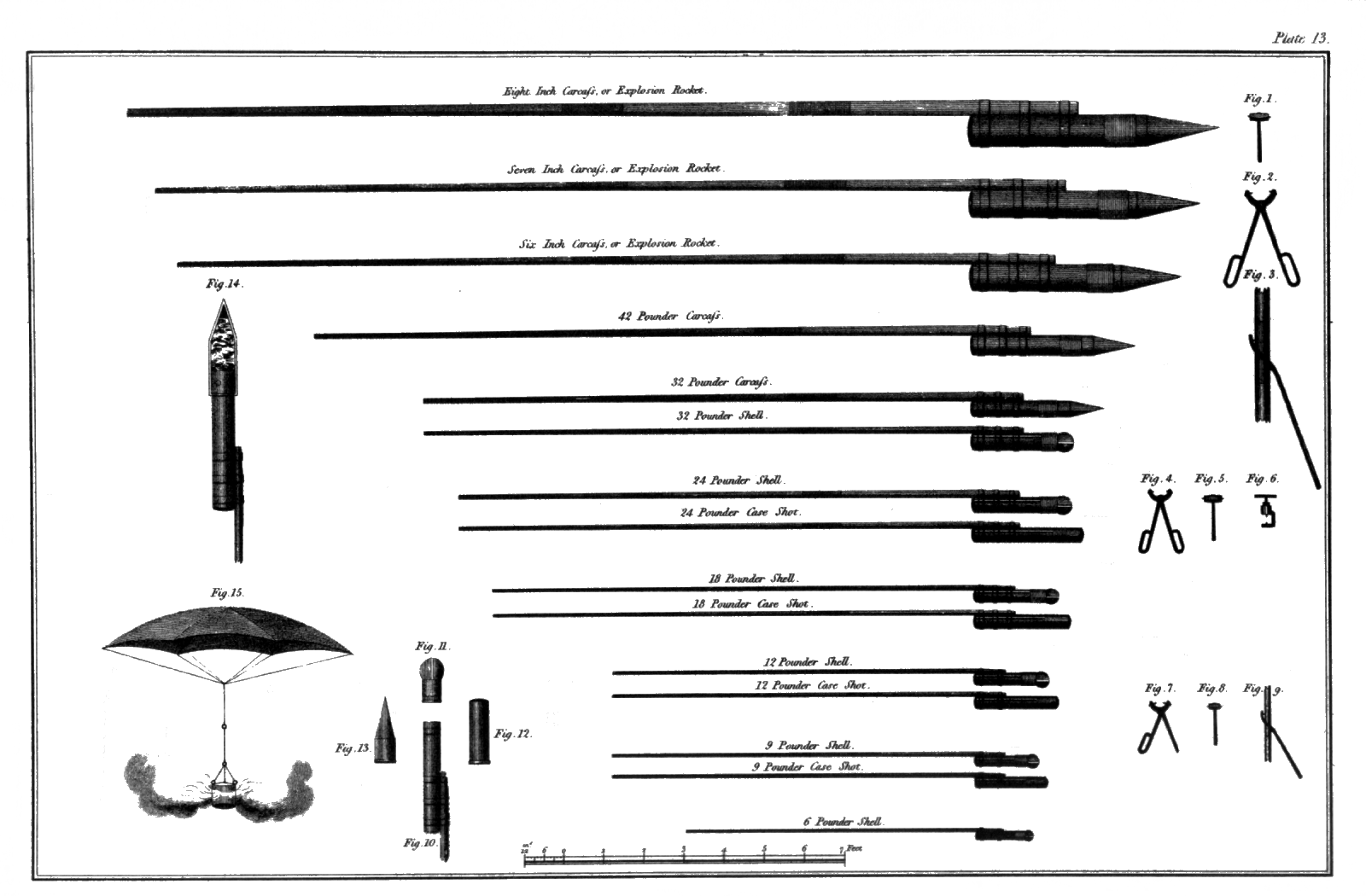
Sir William Congreve’s rocket schematics (1814)
Though tin can mail wasn’t ideal either, due to strong currents, shark-infested waters and adverse weather the swimmers sometimes had to deal with, it was considerably more dependable. In fact, the "buoy mail" approach was only abandoned in 1983, when an airfield was established on the island.
The rocket mail concept once more faded into irrelevance, only to be revived decades later by Hermann Oberth, a physicist and engineer who dedicated much of his career to rocketry and space flight. In the late 1920s, he discussed the idea with an Austrian peer in a series of letters, before delivering a lecture at a German aerospace society meeting in the summer of 1928.
He calculated rockets could deliver up to 44 pounds of mail as far as 1,200 miles, and be guided to a specific landing spot, give or take a few miles. If equipped with secondary boosters that detached mid-flight, Oberth suggested a transatlantic mail run could take as little as 30 minutes, takeoff to landing.
It was an exciting prospect, and there was a poetic irony in it — how an instrument of war could be used to bring people together rather than blowing them apart. High-altitude rocket research in the subsequent years, however, didn’t progress at the expected or desired rate. It wasn’t until the first successful test flight of the German V-2 in 1942, which reached a peak altitude of 52.5 miles, that long-range rocket travel became a reality. Interestingly, the lead engineer of the V-2 program, Wernher von Braun, is said to have first become interested in rocketry as a teen after reading Oberth’s book, Die Rakete zu den Planetenräumen (The Rocket into Interplanetary Spaces).
While Oberth’s grand designs were many years ahead of their time, elsewhere in the world, engineer Friedrich Schmiedl was working at a more practical scale, developing his own, short-range rockets and parachute landing systems. He lived in the Austrian alps, where a journey between two villages would take the best part of a day, despite them only being a few miles apart as the crow flies. In 1928, he conducted his first symbolic rocket mail test with a payload of 19 souvenir letters.
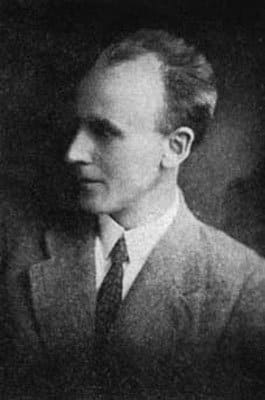
On February 2nd, 1931, his seventh launch transported 102 genuine letters between the towns of Schoeckl and Sankt Radegund. Over the next two years, several other successful flights took place, carrying hundreds of letters between various towns in the mountainous region. But in 1934, the Austrian Post Office banned private mail services, and the following year, the government killed hobbyist rocket development by outlawing the personal possession of explosive material.
Finally, when World War II began in 1939, Schmiedl destroyed all of his work so his research could not be used in the development of military rockets. He remains one of the earliest and most celebrated figures in the history of rocket mail, and has been featured on commemorative stamps issued as far from his homeland as Paraguay.
Throughout the 1930s, experimentation with short-range rocket mail services was carried out all over the world, with varying degrees of success. German engineer Reinhold Tiling began working with rockets in the late 1920s. He is known for developing early forms of cruise missiles (or rocket planes) with fold-out wings that would deploy after launch — these kind of projectiles travel on much lower arcs compared to trajectory-type missiles, which cover large distances by reaching high altitudes.
His creations completed many successful flights in the following years, but his most notable launch on April 15th, 1931, carried 188 postcards as a proof-of-concept for rocket mail. Many of his tests were public demonstrations, and he became a relatively famous rocket pioneer in his homeland of Germany. He continued testing and perfecting a reusable rocket mail design, but died in 1933 alongside two colleagues following a gunpowder explosion at his workshop. His legacy lives on, however, as a cluster of impact craters on the dark side of moon bear his name.
Fellow German engineer Gerhard Zucker is perhaps the most notorious proponent of rocket mail. From 1931 to 1933, he travelled around the country exhibiting his rocket designs, advocating their suitability for mail transport. Of the demonstrations he attempted, most were embarrassing failures, though it’s said he did successfully fly a letter-laden rocket from the German town of Duhnen to Neuwerk Island in the summer of 1933.
In 1934, he emigrated to Britain and soon after, managed to strike up a promising dialogue with the government’s General Post Office. On June 6th, 1934, he successfully launched a test rocket carrying dummy letters from the Sussex Downs towards England’s south coast. The General Post Office hoped rocket mail could benefit areas that were otherwise hard to reach, and asked for another demonstration in Scotland.
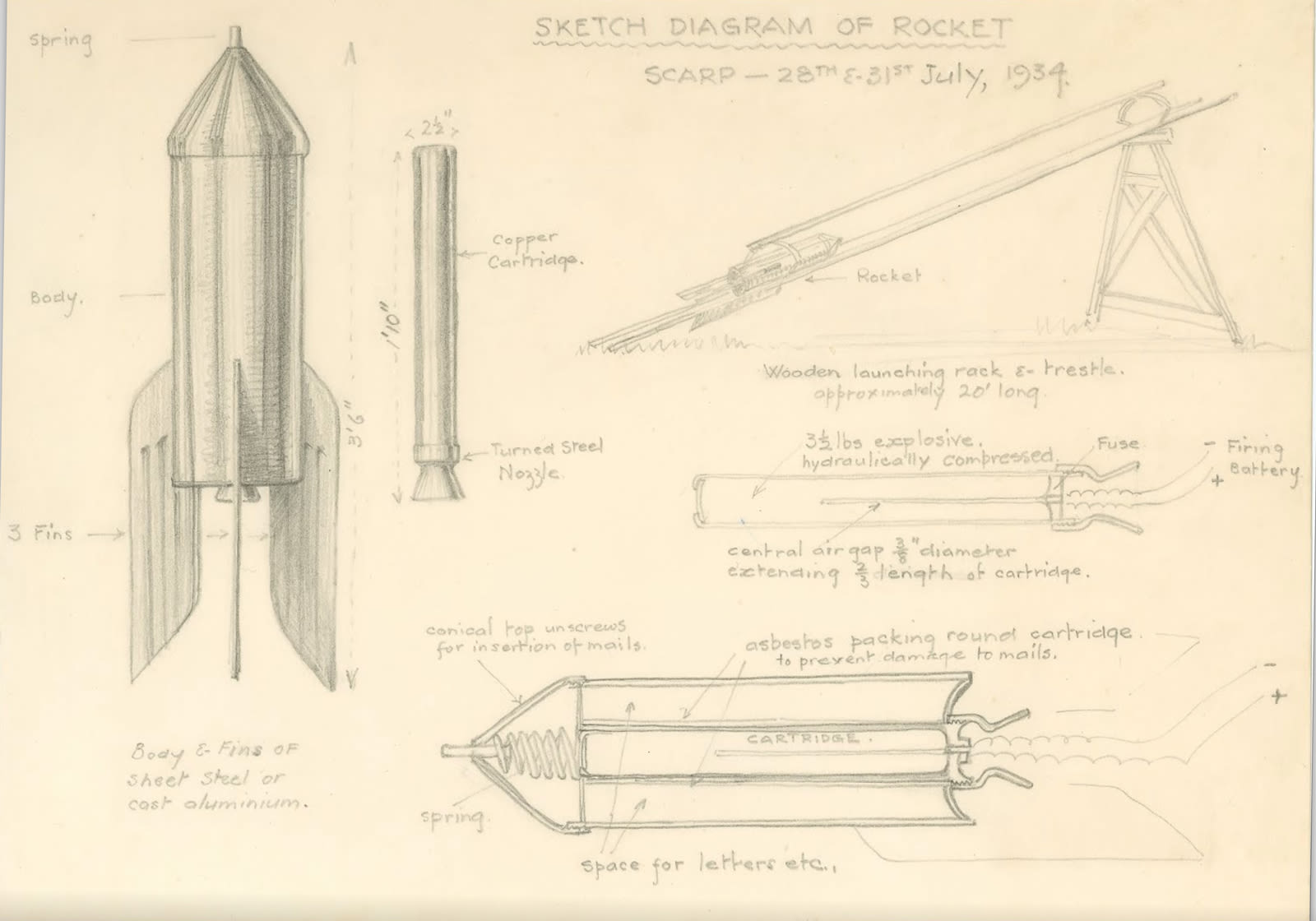
Sketches of Zucker’s rocket used in the Scarp Island test
The following month, a rocket carrying a significant batch of (pre-paid) letters was scheduled to travel a mile from the Scottish mainland to Scarp Island, but it exploded upon ignition. A few days later, the same fate befell a follow-up test. In December 1934, another failed attempt resulted in Zucker being branded a fraud. The government described him as a "threat to the income of the Post Office and the security of the country." He was swiftly deported and arrested by the Gestapo upon arriving back in Germany, where he was suspected of being an ally of Britain.
He survived this encounter, but only on the condition he would cease all rocket experiments. He allegedly played a small part in the German war efforts, but lived the next 30 years in relative obscurity. At some point, he resumed his experimentations and held another public rocket demonstration on May 7th, 1964. This again, was a failure, only this time three onlookers died in the accident, leading West Germany to outlaw private rocket launches in the region. Nevertheless, he continued feeding his obsession throughout the 1970s before his death in 1985. Like Tiling, he too has been immortalized, with the 2004 film The Rocket Post dramatizing his early blunders in Britain.
Around the time that Zucker’s early career ended with humiliation and deportation from Britain, Stephen Smith’s began on the other side of the world in India. Smith had made a living as a customs agent, dentist and policeman, but he also became the most prolific and arguably successful proponent of rocket mail. He had been a student of rocketry since childhood, and combined his passion with his position as Secretary of the Indian Airmail Society with full support from country officials.
He conducted his first rocket mail test on 30 September 1934, using what was effectively a glorified firework supplied by the Oriental Firework Company of Calcutta. The goal was to carry 143 letters from a ship to the shore of Sagar Island. The rocket exploded mid-flight, but 140 of the letters were successfully recovered. Over the next ten years, Smith would orchestrate no less than 270 flights, 80 of which contained mail. He experimented exhaustively with different designs, propellants and launch trajectories, and is credited with the first rocket mail flight over a river and the first parcel delivery by rocket.
Mail wasn’t his only passenger, though. Another of Smith’s firsts was flying an aid package containing food over a river and into a region that had been hit by an earthquake. He’s also the first rocketeer to transport livestock, with a cock and hen called Adam and Eve surviving a flight in the summer of 1935 before living out the rest of their days at a private zoo in Calcutta. A later experiment successfully transported a snake known as Miss Creepy. India’s flirtation with rocket mail ended when Smith completed his last flight in December 1944, though, towards the end of the World War II. Smith died a few years later in 1951.
The 1930s were undoubtedly the most active years in the pioneering of rocket mail. But just as there were visionaries that genuinely believed rocket mail was the future, so there were opportunists. Philately — the collecting of postal material including stamps, envelopes, postcards, etc. — was a very common hobby at the time, and the only reason Schmiedl, Tiling, Zucker and others were able to follow careers in rocketry in the first place. Their experiments were funded almost exclusively by philatelists wanting mail flown by rocket to add to their collections. They were the shiny Charizards of their day.
While there are plenty of examples of historical flights that carried mail with a genuine purpose, there were many more ‘souvenir’ flights. Philatelists would pre-pay for the stamps and postmarks that would become collectables as soon as they left the ground in the belly of a rocket. This would cover the costs of the launch, the rocketeer could test out a new design or propellant; everyone was happy. But while some of the most notable figures in rocket mail’s history funded their enterprises in this way with good intentions, others saw it as a way to make a quick buck.
Karel Roberti, for example, had no engineering or scientific background, but launched his first rocket in the Netherlands in December 1934. It exploded upon ignition. There is no evidence he actually developed rockets, instead purchasing fireworks from Dutch manufacturer, A J Kat. Many of his launches were failures, and conducted in private, likely because there was little spectacle in watching a firework travel a short distance upwards only to land moments later.
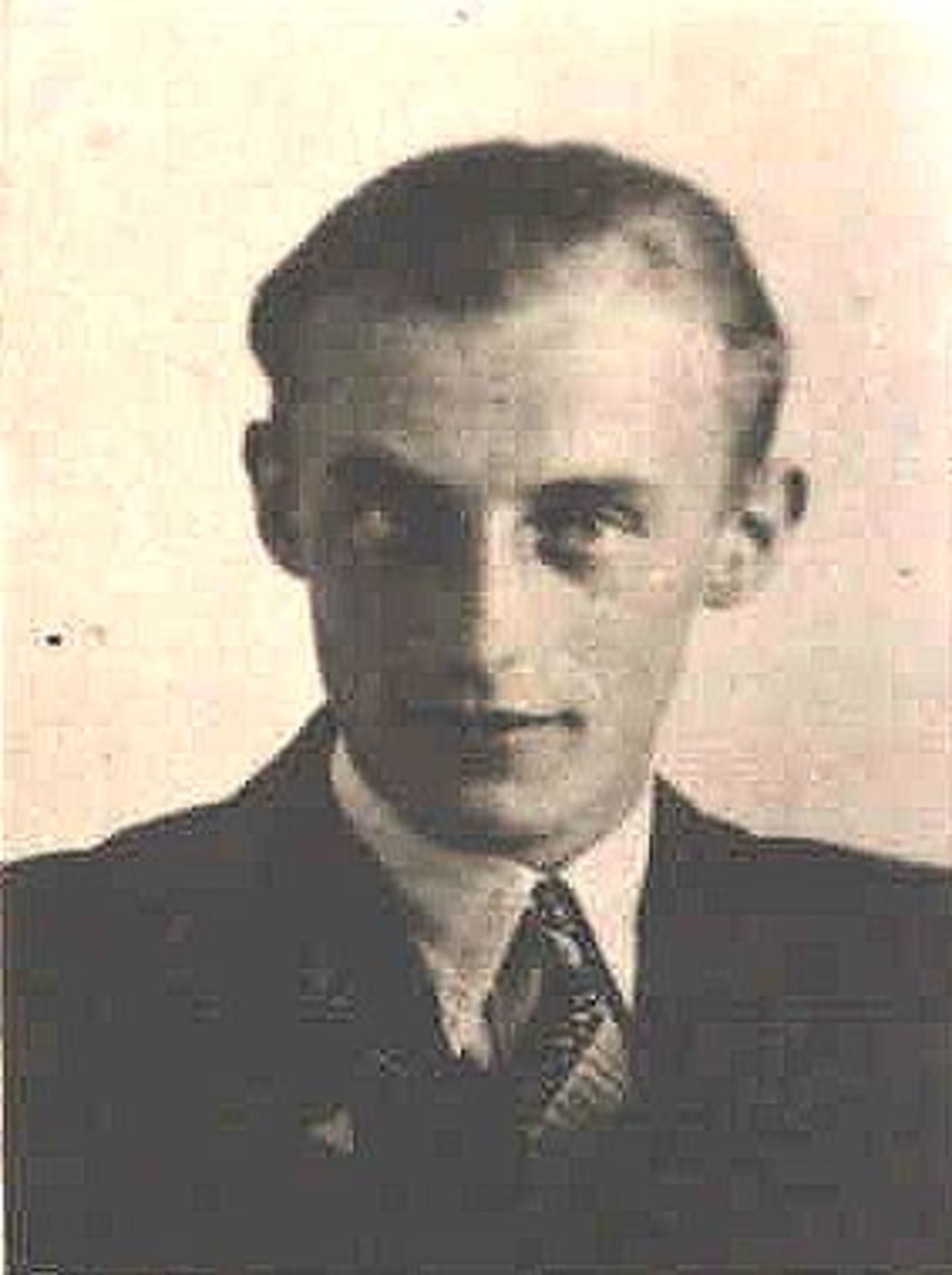
The souvenir mail he flew was adorned with colorful stamps and sold at exorbitant prices by Gerald Thoolen, a renowned stamp-dealer. Thoolen chaired a company called Nederlandsche Raketten Bouw, which roughly translates to Dutch Rocket Construction. The enterprise was generally regarded as a front that was used purely to create an air of legitimacy to the racket. In 1935, Dutch philately magazine Maandblad voor de Philatelie ran numerous articles branding Roberti a conman, and though he conducted a few subsequent launches in Belgium and Luxembourg until 1936, his story ends there.
In 1935, American Frido Kessler had a similar idea. The wealthy stamp-dealer wanted to build his own rocket and cram it with souvenir mail, which he would then sell to enthusiasts for a profit. It wasn’t a scam as much as entrepreneurship, though. Albeit symbolic in nature, the launch was supposed to be a grand public spectacle, not done in secrecy to scam deep-pocketed philatelists.
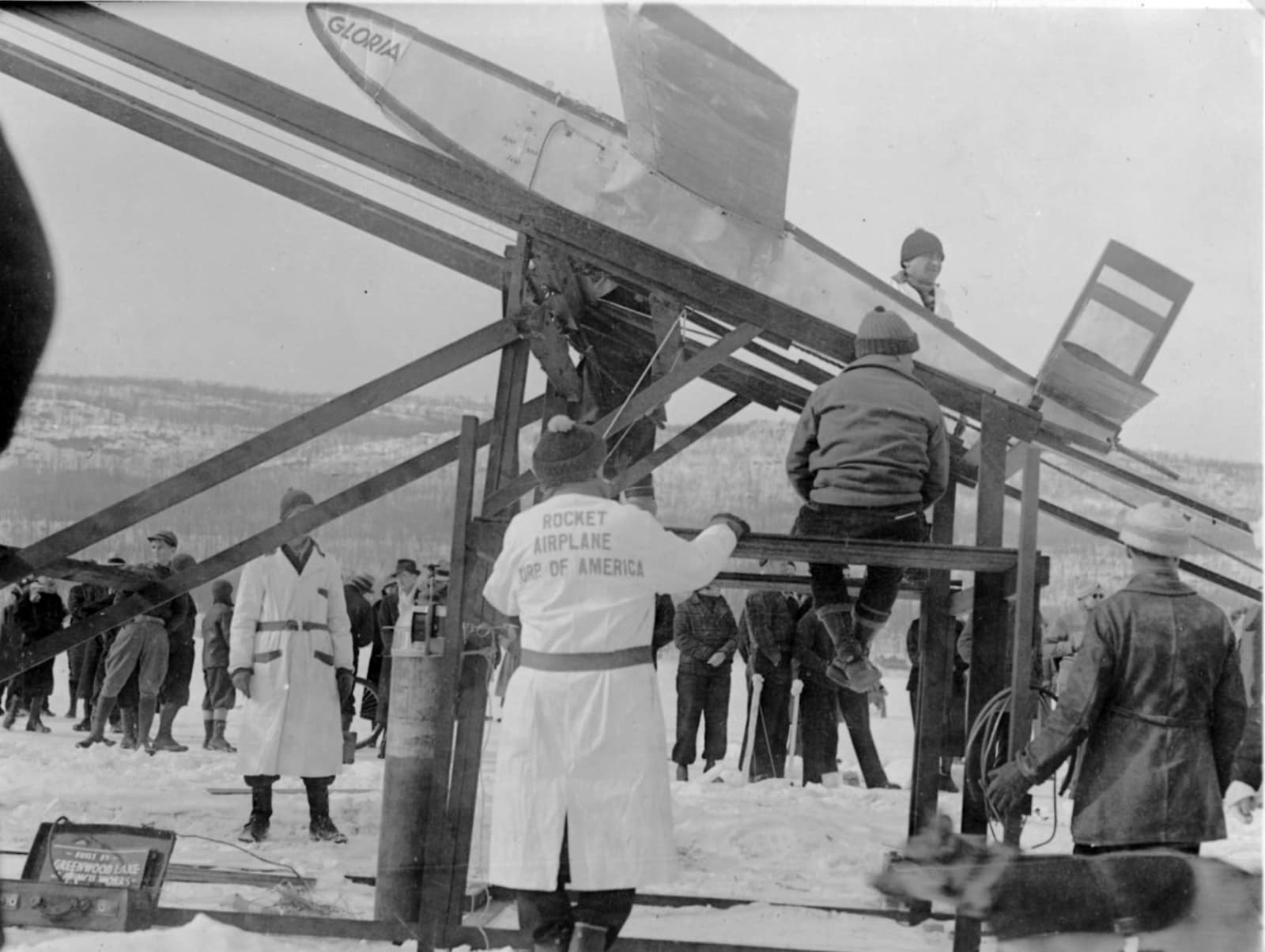
One of Kessler’s rocket planes
Kessler formed a company, Rocket Airplane Corporation, and drafted in experts to design a rocket plane and engine. He ended up commissioning three in total, and thanks to the lobbying of a local stamp collector, selected the frozen surface of Greenwood Lake, New York as the launch site. In the depth of winter on February 9th, 1936, a crowd of spectators trudged through the snow to observe the launch, officials from the Air Mail Service and American Rocket Society among them.
The rocket plane was to be shot from a catapult, and while the engine ignited on the first launch attempt, the catapult release was frozen solid. The rocket did eventually make it off the ramp that day, but landed mere feet from it. Kessler said frozen liquid oxygen propellent and a delayed catapult release was to blame — though he later claimed it was sabotaged by a mechanic who was resentful for not receiving credit for his role in the project. On February 23rd, Kessler tried again, with a CBS radio and camera crew joining the onlookers. He was advised that the weather was still unsuitable, but fearing the public would lose interest, he went ahead with the launch.
It was another failure. Though the plane made it off the catapult ramp, it flew erratically for a short distance before crashing into the ice and suffering irreparable damage. A second plane was wheeled out and this time, it was ignited while it lay flat on the ice. It picked up speed, took off, but one of the wings soon folded to stress and it, too, plummeted unceremoniously into the ice. It had just about made it over the New Jersey state line, however, and the mail bundle was handed over to the postmaster of nearby town Hewitt for processing. Spectators were unimpressed, and while Kessler technically achieved his goal, his rocket mail ambitions ended there.
Also in 1936, though further to the south in McAllen, Texas, American Legion Post workers were trying to think of ways to pay off the mortgage on their new building before the dedication ceremony that summer. The Post Commander’s 16-year-old son, whose hobbies included both rocketry and stamp-collecting, had one: Launch a mail-carrying rocket across the Rio Grande river into nearby Reynosa, Mexico. It would be the first international rocket mail delivery, and selling special stamps and the unique payload to philatelists was sure to be a money-spinner.
After the authorities on both sides of the river eventually came around, or at least agreed to the idea, crude rockets of laminated cardboard, fueled by volatile powder emptied out of firecrackers, were constructed. The first launch attempt met an explosive end almost immediately, but a second rocket easily made the flight and overshot its expected trajectory, coming to rest in the gutter outside the U.S. Bar in Reynosa. Several more launches took place on both sides of the border that day, with varying degrees of success and accuracy. Hundreds of letters were recovered from the launches, earning the McAllen American Legion Post the money they needed to cover the cost of the new building in time for its dedication.
There are many other characters and stories associated with rocket mail’s history. Amsterdam-based dental technician A. J. de Bruijn, for example, had a passion for rocketry. Between 1936 and 1966, he and his colleagues at the Nederlandsche Ruitevaart Studio (the Dutch Space Flight Studio) orchestrated dozens of rocket mail flights all over Europe. Since 1947, the non-profit Rocket Research Institute has also conducted numerous rocket mail launches, primarily for the purposes of fundraising and experimentation. The use of missiles to drop propaganda leaflets during World War II could also technically be considered another successful implementation of the concept.
However, the momentum behind rocket mail — the idea that letters and packages could one day traverse the globe in minutes — slowed around the mid- to late-1930s. Its champions tinkered in isolation, the most ambitious among them still stuck on the hyperlocal scale of the next town over. Philatelists supported them, but this only served to slowly relegate rocket mail to a novelty. It was no longer the future of communication. At best, it was a hobby, and at worst, a scam.
That is until 1959, when the US Postal Service and Department of Defense fired a Regulus I cruise missile stuffed with thousands of letters from the deck of Navy submarine, the USS Barbero. It touched down at a Naval Station 700 miles away in Mayport, Florida, just 22 minutes after setting off. It was the first test of its kind: A true, long-range rocket mail launch that was also state-sponsored, not a private enterprise.
An excerpt from the souvenir letters inside read: "The great progress being made in guided missilery will be utilized in every practical way in the delivery of the United States mail." An excited Postmaster General Arthur Summerfield said at the time, "before man reaches the moon, mail will be delivered within hours from New York to California, to Britain, to India or Australia by guided missiles. We stand on the threshold of rocket mail."
There were no subsequent tests conducted by the Postal Service and/or the Department of Defense, however. It’s generally believed that the launch had nothing to do with missile mail at all, and everything to do with the Cold War. It was an excuse to flaunt the capabilities of the Regulus I for the benefit of the Soviet Union, and at great expense.
Rocket mail had been unjustifiable for a long time already. Even in Schmiedl’s time — when he first began his experiments in the late 1920s — regular zeppelin and airmail services ran locally and internationally in many parts of the world. By 1959, of course, transatlantic airmail flights were a daily occurrence. Rockets had always come at a high cost and their margin for error was unacceptable.
Beyond the general impracticalities, rockets were machines of death; they were things to be feared. Especially after World War II, no bureaucrat could ever entertain the idea of rocket mail. Every ping on a radar screen could be a letter home, or an act of war.
Now, all the communication problems rocket mail was meant to solve barely exist. With the internet and email, letters and documents can be sent and received immediately. You can buy products online and have them delivered within an hour, or send a package across the world in a few days through an express courier service. Last-mile logistical hang-ups are being addressed with autonomous delivery robots, and likely drones in the near future.
In a way, the real forward-thinkers in the history of rocket mail were the philatelists, and the niche of astrophilately is still alive and well. Many decades later, the enthusiasts that funded the earliest experiments have been proven right, and their first edition shiny Charizards still circulate in collectors’ circles today.
Images: Tin Can Mail postcard via WordPress; Congreve rocket schematics via Wikimedia Commons; Herman Oberth via Smithsonian National Air and Space Museum; Friedrich Schmiedl via ESA; Tiling rocket launch via German Federal Archives; Zucker rocket sketch / explosion clipping via The British Postal Museum and Archive; Stephen Smith via The Ottawa Citizen; Envelope flown by Smith via The Rocket Mail Page; Karel Roberti via First Belgian Rocket Post; Kessler’s rocket plane via Gizmodo; U.S. Bar in Reynosa, Mexico via Museum of South Texas History; Arthur Summerfield via Smithsonian National Postal Museum; Zucker article clipping via The British Postal Museum and Archive.
Technological innovation didn’t begin with the development of the first integrated circuit in the 1950s. Backlog is a series exploring the era of possibilities: engineering feats that followed the industrial revolution, quirky concepts the future’s rendered obsolete, and inventions that paved the way for some of the technology we use today.
via Engadget http://www.engadget.com
February 2, 2019 at 10:33AM
https://www.engadget.com/2019/02/03/india-opens-human-space-flight-centre/
Crewed spaceflight is still limited to a handful of countries, but India is close to changing that. The Indian Space Research Organization has formally opened its first facility devoted to human spaceflight. The appropriately titled Human Space Flight Centre in Bengaluru will be responsible for key aspects of Gaganyaan, the country’s crewed orbital vehicle (shown in replica form above). The location will develop crew survival systems, train crew members, plan missions and "pursue activities" for sustained flights.
There’s a lot of work left to do. Gaganyaan will only fly in unpiloted form in December 2020, and the hoped-for crewed mission should take place in December 2021. Many pieces will have to fall into place, and India has faced some of the same teething troubles other space programs have faced. If everything goes well, though, India could have a truly independent way to deliver people to orbit — it wouldn’t have to rely on partner nations. That, in turn, could make spaceflight less of a privileged rarity and more of an everyday reality.
Via: Parabolic Arc
Source: ISRO
via Engadget http://www.engadget.com
February 3, 2019 at 08:30AM

Google dropped two new apps on us this morning, both of which should help deaf and hard-of-hearing people. The apps are called Live Transcribe and Sound Amplifier, and they are available right now for download.
The names for the apps explain pretty well what they do. For Live Transcribe, you have an app that transcribes in real-time as you have a conversation with someone. It puts the words on an easy-to-read black screen using cloud-based automatic speech recognition. It’s like having captions as you move around your daily life.
Live Transcribe is available in over 70 languages and even enables conversation via type-back keyboard.
With Sound Amplifier, you get an app that tries to make sound clear and easy to hear. Google says that it “works by increasing quiet sounds, while not over-boosting loud sounds,” and works with wired headphones to filter, augment, and amplify sounds in the environment too. There are settings for noise reduction and to minimize background noise.
Both are free and available at the links below.
Google Play Links: Live Transcribe | Sound Amplifier
via Droid Life: A Droid Community Blog http://bit.ly/2dLq79c
February 4, 2019 at 10:41AM
https://arstechnica.com/?p=1448339
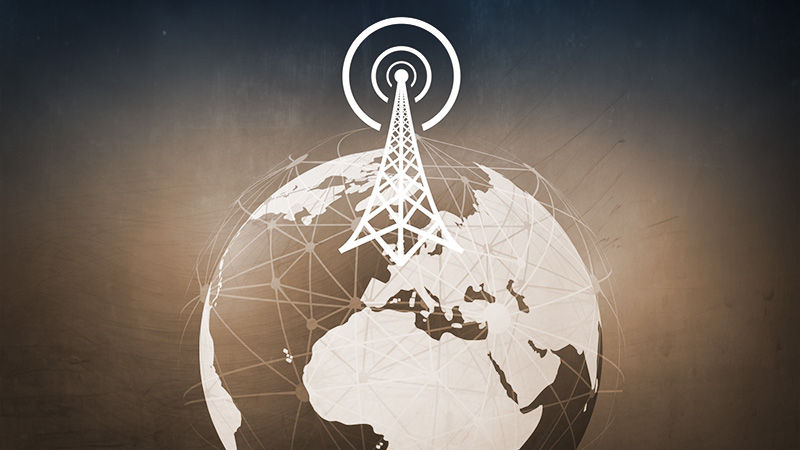
Aurich Lawson
Energy harvesting is all the rage at the moment. I’d like devices that convert waste energy into electricity. If I could, I would fill my house with all sorts of high-tech Rube Goldberg-esque machines for getting an extra few watts back. But Wi-Fi energy harvesting has never impressed me as a potential source of wattage, even though the latest research shows that it might well be getting somewhere.
Most houses and public spaces abound with Wi-Fi signals, but harvesting the energy in those signals is difficult. The first challenge is to collect the radiation.
Collecting the radiation requires some near-impossible antennas. The antennas must be omni-directional, meaning they absorb radiation from all directions equally well. The antennas should also absorb all the radiation that hits them, which ain’t an easy task either.
To get this to happen, the spatial configuration of the antennas has to match the spatial configuration of the Wi-Fi radiation. That latter configuration is not just unknown, but it changes with time.
Nevertheless, there has been a lot of progress here. Antennas that can absorb well over 90 percent of incoming energy have been demonstrated. But these don’t operate on all Wi-Fi bands and/or don’t absorb radiation from every direction.
Assuming that these issues could be solved, the next problem is to turn the absorbed radiation into a useful source of electrons. You may have noticed that most of your low-power gadgets—your phone, tablet, and watch—run on direct current (DC). The antennas that absorb Wi-Fi radiation provide you with alternating current (AC). And, unlike the current from a wall socket, this is hard to convert to DC.
Depending on where you are in the world, grid power has a frequency of 50 or 60Hz. This is converted to DC by a network of diodes that only allow current to flow in one direction. Diodes, however, have to switch on and off, which takes time. This is where the problem lies. For a 60Hz signal, switching in a microsecond is adequate. For WiFi signals, which are at 2.4 GHz and up, you probably want to switch in a picosecond (10-12s).
The diodes need to switch fast, but in practice, their switching speed depends on the size of the AC voltage. Applying 12V to a diode will cause it to switch much faster that applying a few millivolts. Yet our Wi-Fi antenna is going to be supplying millivolts at best. Most likely, the diode is going to be asked to switch microvolts or nanovolts, which drops the speed considerably. As a result, the power-conversion efficiency falls off a cliff.
The antenna might absorb 90 percent of the Wi-Fi signal, but the diode promptly loses between half and 95 percent of that, depending on the Wi-Fi signal strength.
I honestly didn’t see much prospect for improvement either, because these diodes are critical components in Wi-Fi transceivers. Engineers have been making them as efficient as possible for many years, and improvements have slowed considerably. Essentially, we’ve pushed the limits of the materials that we’re using (silicon and germanium), which determine how fast the diode can switch.
The solution, then, is to change materials. A team of researchers created diodes based on a 2D material, called molybdenum disulfide (MO2S). Molybdenum disulfide changes from a semiconductor to a conductor with a bit of chemistry.
A diode based on a combination of metallic electrodes, a tiny slice of semiconducting molybdenum disulfide, and conducting molybdenum disulfide was created. This diode switches very fast, even when the applied voltage is very low. That’s because diode switching is fast if the diode cannot store charge, and a 2D material has no room to store charge.
The researchers built flexible Wi-Fi antennas that also contained the diodes and went in search of waste energy to recover. The diodes work, but at signal levels that might reasonably be expected, the efficiency was below 10 percent. That number, however, is not the end of the story. In this case, the researchers really focused on making a good diode, while the antenna design was as simple as possible. Combined with a good antenna, the researchers might double their efficiency.
The actual achievement of this research is substantial. The antenna plus diode was just a start; the researchers also demonstrated an integrated mixer (a key component in radio transceivers) built into a flexible antenna. This opens up the possibility of nice form-matching Wi-Fi systems with more efficient transceivers. I like that.
Is Wi-Fi energy harvesting going to be a thing though? Probably not. A lot of tiny, low-power devices out there might be Wi-Fi powered. But the amount of energy harvested by a Wi-Fi antenna is directly proportional to the area of the antenna. Those tiny devices may not be so tiny once the energy harvester is added. So, my skepticism remains.
Nature, 2019, DOI: 10.1038/s41586-019-0892-1 (About DOIs)
via Ars Technica https://arstechnica.com
February 4, 2019 at 05:46AM
https://arstechnica.com/?p=1450691

Elon Musk/Twitter
Elon Musk has been at SpaceX’s test site for its rocket engines in central Texas this weekend. The facility near McGregor is where the company both tests Merlin engines for Falcon 9 flights, and also performs some experimental firings.
Due to a variety of reasons including financial pressures, SpaceX is pushing hard on the development of its next-generation Super Heavy rocket and Starship spacecraft. This was evidenced this weekend when, at 1:15am Central Time on Sunday morning, Musk shared a nighttime picture of himself on the test stand at McGregor, saying “with engineering team getting ready to fire new Raptor rocket engine.” It was the dead of night on Super Bowl weekend, and they were working on an engine that won’t go into space for a few years. But that didn’t matter.
The test itself appears to have taken place later on Sunday. Eyewitness reports in Central Texas noted a large pop on Sunday evening, and more later Sunday night. Musk himself tweeted a photo shortly before 10pm local time, and thereafter a video. The test firing itself lasts for a few seconds, and was evidently successful. “First firing of Starship Raptor flight engine! So proud of great work by @SpaceX team!!” Musk wrote.
— Elon Musk (@elonmusk) February 4, 2019
Engineers can do a lot of analysis on a rocket motor prior to putting it on a test stand, but there is no substitute for lighting the candle and seeing what happens. One of the most important things that rocket scientists will study during these early test firings is the color of the flame. In this case, the rocket engine’s exhaust turns green toward the end of the test firing. This was likely due to a slight burning of copper liner from the engine chamber. This should not have burned, and fixing this will likely require adding more insulation. However, initial test firings are designed precisely to detect such issues and will ultimately lead to a better engine. Generally, any “first” test firing of a new, full-scale rocket engine that doesn’t end in an uncontrolled explosion is a good thing.
Musk and SpaceX have a lot riding on this engine, as it will power both the Super Heavy rocket during launch and the Starship spacecraft in space. This particular engine may end up as one of three engines used as part of the “hopper” tests of a Starship model later this spring, when the vehicle ascends into the lower atmosphere and then descends on its own power. The first launch of the rocket and Starship combined should come in the early 2020s.
via Ars Technica https://arstechnica.com
February 4, 2019 at 08:03AM